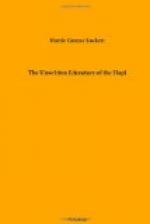[Footnote 8: Voth, H.R., Traditions of the Hopi: Field Columbian Museum Pub. 96, Anthropological series, vol. 8, pp. 36-38, 1905.]
Sons and daughters are expected to marry outside the clan, and the son must live with his wife’s people, so does nothing to perpetuate his own clan. The Hopi is monogamous. A daughter on marrying brings her husband to her home, later building the new home adjacent to that of her mother. Therefore many daughters born to a clan mean increase in population.
[Illustration: Figure 1.—Hopi Family at Shungopovi.
—Photo by Lockett.]
Some clans have indeed become nearly extinct because of the lack of daughters, the sons having naturally gone to live with neighboring clans, or in some cases with neighboring tribes. As a result, some large houses are pointed out that have many unoccupied and even abandoned rooms—the clan is dying out. Possibly there may be a good many men of that clan living but they are not with or near their parents and grandparents. They are now a part of the clan into which they have married, and must live there, be it near or far. Why should they keep up such a practice when possibly the young man could do better, economically and otherwise, in his ancestral home and community? The answer is, “It has always been that way,” and that seems to be reason enough for a Hopi.
=Property, Lands, Houses, Divorce=
Land is really communal, apportioned to the several clans and by them apportioned to the various families, who enjoy its use and hand down such use to the daughters, while the son must look to his wife’s share of her clan allotment for his future estate. In fact, it is a little doubtful whether he has any estate save his boots and saddle and whatever personal plunder he may accumulate, for the house is the property of the wife, as well as the crop after its harvest, and divorce at the pleasure of the wife is effective and absolute by the mere means of placing said boots and saddle, etc., outside the door and closing it. The husband may return to his mother’s house, and if he insists upon staying, the village council will insist upon his departure.
Again, why do they keep doing it this way? Again, “Because it has always been done this way.” And it works very well. There is little divorce and little dissension in domestic life among the Hopi, in spite of Crane’s[9] half comical sympathy for men in this “woman-run” commonwealth. Bachelors are rare since only heads of families count in the body politic. An unmarried woman of marriageable age is unheard of.
[Footnote 9: Crane, Leo, Indians of the Enchanted Mesa: Little, Brown & Co., Boston, 1925.]
=Woman’s Work=
The Hopi woman’s life is a busy one, the never finished grinding of corn by the use of the primitive metate and mano taking much time, and the universal woman’s task of bearing and rearing children and providing meals and home comforts accounting for most of her day.




